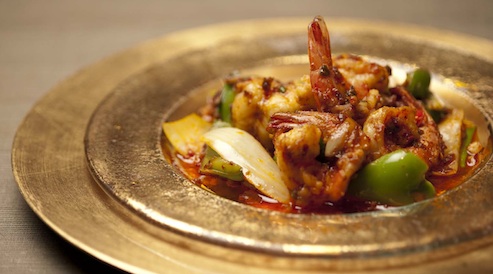
You know that you are in love with a country’s cuisine when you start to crave certain local dishes like green mango salad, spicy prawn soup, mango with black sticky rice. My first trip to Bangkok was in 1994 and since then I fell in love with Thai food, taking classes at Bangkok’s Mandarin Oriental Cooking School and at the local culinary institute.
While every Asian country can lay claim to being the most food-obsessed, the Thais have incorporated their philosophy in their everyday language. Food is so important that common expressions use food analogies: Mai kin sen literally means not eating noodles and is used when two people have fallen out; sen yai means big noodle and refers to a VIP or important person.
Food and eating are important parts of the Thai culture that have evolved over time to reflect the numerous influences from other countries: From China, comes a fondness for noodles and quick stir-fry methods, from India a profusion of spices, from Cambodia and Burma rich stews and from Portugal, the all important chili and other key food ingredients. With a strong love for food, the Thais have embraced new ideas over the past several centuries and incorporated the best parts into what evolved to become Thai cuisine.
Thai cuisine places an emphasis on the generous use of fresh, raw vegetables and herbs, the most common of which include kaffir lime leaves, galangal, lemongrass, coriander and Thai basil. Also, the sheer intensity and sharpness of all the key flavours — sweet, sour, spicy and salty. Nearly all of these essences are incorporated into Thai dishes, whether it is a simple yam, a stir-fried noodle dish or a curry dish. Despite the elevated intensity, each dish retains its own balance and harmony of flavours. This aspect of balance is central to Thai cuisine and evident in popular dishes such as yams (salads) which brings together a myriad of characteristics including tangy sweetness from raw, unripe fruits, additional sour flavours from lime, salty tastes from fish sauce, citrus herbal notes from lemongrass and fresh herbs like coriander, mint and spicy savour from sliced red hot chilis.
Local wine options exist and those from Siam winery or Granmonte can be uncomplicated, clean and refreshing and are good accompaniments to spicy Thai dishes. Try Monsoon Valley’s Colombard, one of my favourite whites from Thailand. The soft, juicy red wines from Granmonte can be a good accompaniment with many stir-fried beef and chicken dishes.
Thai food has both strong flavours and distinct fragrances from the abundant use of fresh herbs and thus, can often overpower the aromatics of wine. Wines with sufficiently vibrant fruit and intense aromatics are optimal. So look for fruity wines with youthful, bright expressions.
In addition, high levels of tart and sour flavours in the salads, relishes and even soups, which are part of every meal, require wines with very firm acidity. Look for wines from relatively cool regions – Pinot Noir from Alsace, Pinot Blanc or Riesling from Germany or Gewurztraminer from Northern Italy.
Chilis are used in nearly every dish or are closely at hand, often found floating in the ubiquitous phrik naam plaa (fish sauce). This intensely salty and spicy combination makes pairing red wines with Thai food especially challenging. Ideally, given this and the relative lightness of the dishes, numerous white wines are often better paired with Thai meals. However, if one prefers reds, there are many light to medium-bodied reds with fairly low tannins that would work well – think New Zealand Pinot Noir, young Valpolicella, Dolcetto or sparkling Rose wines.
The sweet flavours in many of the dishes on the table from tropical fruits or coconut milk, means off-dry and even chilled medium sweet wines can work well. Rieslings from Germany, off-dry Chenin Blancs from the Loire, late harvest aromatic whites from Alsace all have the essential ingredients to balance Thai food: Very firm, crisp acidity, intense fruit characteristics, relative lightness in body and an element of sweetness that can echo the sweet flavours in the food.
Thai food has intensity and a bright, vibrant brilliance. Wines with equally bright fruit, sharp intensity that is balanced by firm acidity are perfect partners to many Thai dishes. Reach for wines from cool climates around the world that have inherently high acidity and bright fruit and it is hard to go wrong.
Reprinted with permission from WinePress









